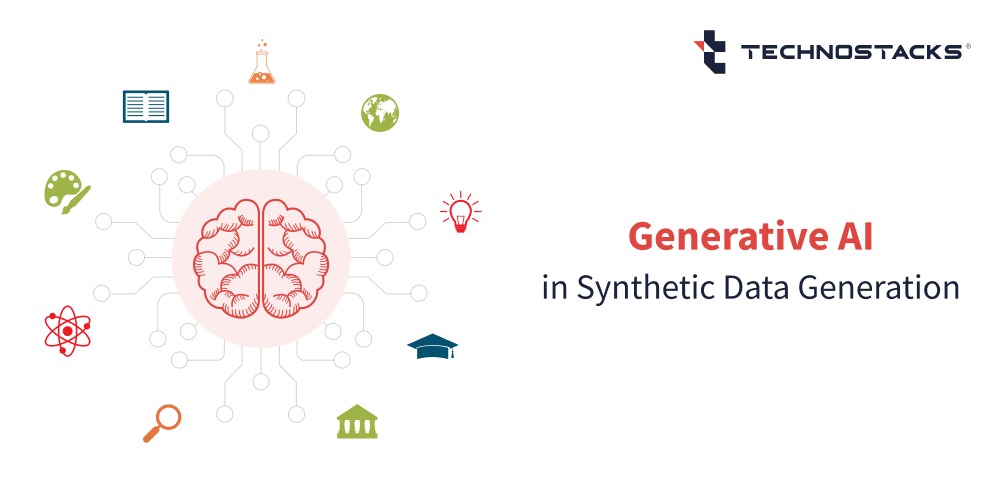Generative AI in Synthetic Data Generation
Generative AI is a precise category of AI-based solutions that can generate different kinds of content comprising textual, graphics, audio-based, and synthetic data sets. Innovative user interfaces steer it to produce quality content, graphics, and videos in seconds.
Generative AI was introduced through chatbots and is now driven by generative adversarial networks or GANs. GANs are a category of machine learning (ML) algorithms that generative AI uses to create content related to real data.
According to a report of exploding topics, 70% of Gen Z individuals have experimented with generative AI tools, and it is projected that 95% of customer interactions may involve AI by 2025. These statistics indicate the widespread applicability of generative AI across all industries, with the generation of synthetic data being highlighted as one of its most significant use cases.
AI-generated data helps create synthetic data based on patterns and relationships gained from actual data sets. In this blog, we will discover generative AI’s abilities and how it generates effective synthetic data sets.
What are the Challenges of Using Real Data?
Real data sets are universally present everywhere. From social media to digital transactions, we create massive amounts of data sets every day. With its enormous potential, higher quality data is leveraged to make precise decisions and improve the future of businesses.
But many times, the real data sets are too tough to gather, highly expensive, or sensitive to be leveraged for research and analytics.
Here you can use synthetic data instead of real data that imitates the properties and patterns of real data. This enables researchers and data analysts to gain insights cost-effectively without utilizing real, personal, or subtle information.
What is Synthetic Data?
Synthetic data is information that is created through software to enhance or substitute real data to advance AI models, safeguard confidential data, and eliminate bias.
It is software-generated information for training AI models that have turned crucial in this data-steered world. It is cost-effective to create, comes labeled, and evades many of the logistical, principled, and confidentiality challenges that come with training deep learning models on real instances.
AI-generated synthetic data require a large sample data set from which the Generative AI models can acquire explicit information. These models use the novel data as an input to explore the characteristics of that data.
How Synthetic Data is Produced Using Gen AI?
Synthetic data is sample-based. To produce it, you require a big sample data set for the Generative AI models to pick up from. The AI models leverage the original data set as an input to explore the aspects of that data to a greater extent. The produced synthetic data appears like the real data and possess all the applicable statistical insights.
Unstructured synthetic data are synthetic imageries and video-based content. On the other hand, structured synthetic data is a tabular information set wherein information points and their relationships are vital aspects.
Tabular data comprise financial transaction archives, healthcare journeys of patients, and CRM catalog. Most of these categories of data designate human behaviour in a sequential approach and are called as time-series data sets.
Related Article:- How to Create AI Software?
What are the Key Advantages of Synthetic Data?
This ability to generate synthetic data has several advantages. These include crafting realistic virtual environments for enabling simulation and produce new insights for machine learning (ML) models.
Synthetic data can be securely used as an alternative to real data. For instance, training data sets used for machine learning models and facilitating data sharing.
It can be further generated, directly and indirectly, to enable data insights, facilitate AI for data production and analytics, develop software, and drive machine learning solutions.
Generating synthetic data provides numerous benefits to businesses:
Quick turnaround time for automated data generation technology projects
Data collection and training is often a blockage in developing precise workflows. By leveraging synthetic data, companies quickly craft quality data sets to utilize in simulations.
This scenario quickens the involved development procedure and enables teams to concentrate their efforts on the analysis instead of information collection.
Synthetic data is leveraged to create data sets for projects with shorter timelines, like A/B testing or swift prototyping. With this approach companies rapidly and precisely test diverse scenarios. They can better craft and deploy experiments with simulations and comprehend their clients, services, and products.
Lower costs allied with information management and data analysis
Conventional data-gathering approaches are expensive, time-consuming, and resource-exhaustive. By leveraging synthetic data sets, companies diminish the costs linked with data gathering and storing.
This is particularly advantageous for small-sized businesses or startup companies with restricted resources, as it enables them to execute analyses that would otherwise be too costly or time-consuming.
In addition, synthetic data is much more informal for storage and manipulation, eradicating the necessity for exclusive hardware and costly software.
This assists company businesses to save funds on data storage and sustenance costs, facilitating them to concentrate their resources on other facets of their company business.
Enhanced performance and productivity in machine learning algorithms
Synthetic data lets companies create massive and different data sets, which assists machine learning algorithms to acquire and simplify healthier. Furthermore, it discourses challenges like overfitting, where the involved model executes well on the training data sets but ails on new, hidden data.
By synthesizing fresh data points, synthetic data assists in preventing overfitting and enhances the oversimplification abilities of ML-based models.
Additionally, synthetic data is leveraged to balance class distributions, better work with missing values, and craft innovative functionalities that may be pertinent to the activities at hand.
By leveraging it to enhance or substitute real data, companies enhance the performance and precision of their machine-learning algorithms, driving enhanced outcomes and more active decision-making.
Related Article:- Ways Machine Learning Can Be Used In Finance
Better control over the superior quality and format of the involved data
With out-of-date data-gathering approaches, organizations are often restricted to the data set that is accessible to them, which may not be in the format or excellence they require.
Synthetic data, on the other hand, is created to meet precise, higher quality and format needs, making sure that the data sets are fit for a specific use case or situation.
This enables companies to regulate and personalize the properties and patterns of their data set and adapt it to meet their requirements and provisions, steering more exact and consistent evaluation.
Moreover, synthetic data can better adapt, enabling data teams to assess and polish their models without the requirement for added data gathering.
Reduction in any bias, enhanced data security and boost in collaboration
Generating synthetic data has a greater effect on company businesses by dipping bias and enhancing data safety. Synthetic data enables firms to craft demonstrative samples that imitate the primary population, dropping the risk of biased results and endorsing fairness and impartiality in decision-making.
Due to its privacy-preserving possessions, synthetic data is effortlessly distributed amid company teams allowing enhanced collaboration and encouraging acquaintance sharing.
This enables teams to better collaborate on data sets in an entirely anonymized and have safe approach while still conserving the veracity of the data sets.
In addition, synthetic data is leveraged to craft virtual replicas of data, which are then discovered, verified, and shared with professional stakeholders. With this approach, teams can easily experiment in a safe and regulated setting with more suppleness and control over the information they utilize.
Challenges in Generating Synthetic Data
Well, while synthetic datasets offer several advantages, there are also some challenges to be aware of.
- Strain in generating multifaceted data sets
- Deficit of complete realism and precision
- Reliance on the real data sets
- Exertion validating and verifying synthetic data
- Unfairness and confidentiality concerns
Which Industry Field Will Have the Highest Impact of Generative AI?
Generative AI enables machines to craft and produce data sets that closely look like and work as human-generated content. In the realm of Healthcare, FinTech and Insurance, this specific technology is composed to make a strong effect, and the data sets back its likelihood.
1. Health Care Industry
Generative AI has proved its competence in numerous healthcare domains. For instance, in medical imaging, Generative Adversarial Networks (GANs) have offered inspiring outcomes.
Many medical facilities have reported that GANs enhanced their diagnostic precision in diseases with a higher margin.
The combination of Generative AI in the healthcare domain is composed to crack a realm of transformative potentials, transforming how to better approach diagnostics, treatment forecasting, and the alliance between AI and healthcare professionals.
Related Article:- Benefits of Artificial Intelligence in Healthcare
The real-world applications of generative AI in healthcare domains include –
- Medical image creation and improvement in healthcare AI data solutions
- Natural language processing solutions for enabling electronic health records
- Drug detection and highly effective molecular modeling
- Empowering with predictive analytics, chatbots and virtual assistants
- Resource and technology optimization in diverse medical use cases
- Medicine interaction estimation and data analysis
- Enabling medical research, insights, and healthcare innovation
Related Article:- AI In Healthcare – Use Cases, Statistics, Real-world Applications
2. FinTech Industry
From improving safety measures with fraud detection to customizing the financial banking experiences and using AI stock picking, generative AI in fintech is maturing every single day.
Generative AI can smartly process and analyze massive financial data sets, automate business tasks, and make forecasts, which makes it an essential tool for several financial applications.
The collaboration between generative AI and fintech facilitates financial institutions to make more well-versed decisions, easily deal with risks, and offer their customers with personalized services.
The real-world applications of generative AI in fintech domains include –
- Transform from digital to smart organization
- Enable fraud detection and find its resolutions
- Augment human capabilities by using automation
- Meet and accelerate regulatory compliances
- Reduce economic and financial crimes
3. Insurance Industry
Accepting AI is not a bold step, and it is a needed step towards the forthcoming scenarios of work in the insurance sector. Generative AI is shaping the insurance value chain, improving performance, and upsurging customer fulfillment. From product development to underwriting procedures and dealing with claims, the potentials are boundless.
With its high capacity to analyze data sets, produce content, and make forecasts, generative AI provides an extensive range of use cases for insurance firms.
Insurers that accept it stand to gain a viable edge by using its abilities to meet the transforming requirements of their customers and commerce.
The real-world applications of generative AI in insurance domains include –
- Enable underwriting to evaluate risks by analyzing massive data
- Help in processing claims, finding inconsistencies, and fraud detection
- Automate insurance quotes, business policies, and related documentation
- Assist with customer support, stakeholder interactions, and user engagement
- Analyze data and preferences to enable customers to upsell or cross-sell openings
The Key Role of Generative AI in Precise Synthetic Data Generation
Generative AI’s capability to create synthetic data is enormously substantial across numerous fields. It facilitates the formation of realistic virtual environments that serve as exceptional training and simulation grounds.
In addition, generative AI is critical in provisioning innovative data sets to enable and guide machine learning models.
Confidentiality Safeguarding
Generative AI can craft synthetic data that imitates real data’s statistical characteristics while not covering any personally identifiable data. This is vital in different industries where data confidentiality regulations are rigorous.
Data Assortment
Synthetic data can be created to present extensive scenarios that might not be present in the partial real data accessible. This assortment can advance the sturdiness of machine learning models and assist them generalize healthier.
Use Cases of Synthetic Data
Several industries and sectors can gain from leveraging synthetic data. From medical and finance to fraud detection solutions, synthetic data sets have precise applications universally.
Let us explore instances of generative AI and synthetic data application across varied domains.
Machine learning solutions
Synthetic data is leveraged for training of machine learning models when real data is affluent or postures secrecy threats. Furthermore, machine learning data generation supplements prevailing data sets when production data is rare or does not exist.
Financial services
Financial services can leverage synthetic data to anonymize confidential customer data, safeguarding development, and testing procedures.
In addition, synthetic data can play a vital role in supplementing the restricted fraud detection data sets, in that way refining the efficiency of detection algorithms.
Medical services
The medical sector gains incredible assistance from synthetic data. Medical organizations can create synthetic medical records to back research activities deprived of breaching subtle patient privacy.
In the same way, researchers can leverage Generative AI to craft synthetic medical images, like CT or MRI scans, that are crucial for training AI-driven algorithms and ML-based models.
This scenario eradicates the necessity for real patient information, which is difficult, facilitating the generation of wide data sets for research-based tasks in the medical sector.
Retail and digital marketing
Companies can utilize synthetic data to advance pricing tactics, comprehend user behavior, and improve digital marketing automation.
Automotives
Synthetic data is significant in designing self-driving vehicles, as it enables for wide-ranging testing and authentication without the requirement for real-world testing.
Insurance services
In the insurance segment, synthetic data can be valued for producing replicated claims data sets. This can simplify the modeling of varied risk setups and lead to the development of accurate and unbiased policies while conserving the secrecy of genuine applicant data sets.
Significant Synthetic Data Generation Methods and Approaches
For developing a synthetic data set, advanced data generation methods and techniques are utilized:
Statistical Distribution Method
In this method, you must draw numbers from the distribution by detecting the real statistical distributions, and realistic data should be replicated. In some scenarios where real data is not obtainable, you can utilize these factual data sets.
If a data scientist has the right kind of statistical distribution in real data, he can craft a data set that will have a haphazard distribution sample.
All this can be attained by the standard distribution, chi-square distribution, and exponential distribution. The trained model’s precision is deeply reliant on the data scientist’s knowhow in this technique.
Agent to Model Approach
With this technique, you can craft an explicit model which will comprehend observed behavior, and it will create arbitrary data with a similar model. This is appropriate data to the known distribution of data sets. Companies can utilize this technique for synthetic data creation.
Machine learning approaches can be utilized to fit the precise distributions. However, when the data scientist needs to foresee the future, the decision tree will overfit because of the straightforwardness and going up to complete deepness.
When some part of the real data is obtainable, companies can leverage a hybrid method to develop a data set based on statistical distributions and create synthetic data leveraging agent modeling based on explicit real data.
Leveraging Deep Learning for Data Synthesis
The usage of deep learning models leverages a variational autoencoder or generative adversarial network for AI data synthesis and artificial intelligence data creation.
GAN and adversarial are competing neural networks. GAN is the generator network that is accountable for crafting synthetic data. An adversarial network works by shaping a fake data set and the generator is reported about this acumen.
The generator will then alter the subsequent group of data set. With this approach, the discriminator will enhance the exposure of fake assets.
So, generative AI applications can advance data quality by artificially inspiring data sets with added information like the real data set but not formerly seen. This assists in enhancing the overall performance of deep learning algorithms, which needs massive and higher quality data sets to work efficiently.
Diverse Generative AI Tools
Here is a quick overview of the top 5 generative AI tools that apply and better uses Generative AI methodologies:
1) GPT-4
GPT-4 is the modern-day version of OpenAI’s Large Language Model (LLM), built after GPT-3 and GPT-3.5. GPT-4 is more innovative and precise while being secure and robust compared to earlier models.
2) ChatGPT
ChatGPT enables the user base free access to fundamental AI content development. It has also launched its premium subscription for users who require added processing authority and access to ground-breaking functionalities.
3) AlphaCode
This model is more multifaceted than many prevailing language models, such as OpenAI Codex. The tool delivers training in several development languages, comprising C#, Ruby, Java, JavaScript, PHP, Python, and C++.
4) Gemini
It is a chatbot and content generation tool built by Google. It leverages LaMDA, an adaptable model. it is designed to empower creators and innovators. Gemini stands out for its versatility and the quality of its output, which has been fine-tuned through extensive training on diverse data sources. Whether it’s crafting a compelling narrative, composing a piece of music, or designing a visual artwork, Gemini’s capabilities are pushing the boundaries of what’s possible with AI.
5) StyleGAN
It is an effective choice when generative AI tools for pictures or images are explored. It utilizes deep learning algorithms to create accurate and superior quality images. It helps startups conduct diverse projects due to its capability to craft visually gorgeous images.
Key Takeaways
In conclusion, the lively blend of Generative AI and Synthetic Data will alter the data landscape. These techniques address critical challenges efficiently, from data insufficiency and privacy apprehensions to compliance with regulations and discovering innovative potentials for AI development.
We also explored how to generate synthetic data using deep ML generative models. So, the future of synthetic data looks highly capable as the applications across sectors are quickly expanding. Its ability to offer different, rich, and privacy-complaint data sources can be the key to cracking innovative AI solutions and driving them to a more data-enabled future.
FAQs
1. What is synthetic data?
Synthetic data is insight that is artificially created rather than crafted by real events. Characteristically crafted to better utilize algorithms, synthetic data can be enabled to verify mathematical-based models and to teach machine learning models. Data created by a computer simulation can be viewed as synthetic data.
2. What are generative models for synthetic data?
Generative models are AI algorithms developed to explore patterns and synthetic data; a subset of generative AI has a substantial strategic reputation for businesses. There are numerous generative models in AI, which are utilized as per the requirements of every project.
3. What is GANs for synthetic data generation?
Generative adversarial networks (GANs), is an algorithmic structure that is built of two neural networks, which are in rivalry with each other to create innovative, replicated instances of data sets that can permit for real data.
4. What is synthetic data in AI?
Synthetic data in AI is information that is artificially generated. It is produced algorithmically and is leveraged as a substitute for test data sets of real data, to verify mathematical models and to train diverse ML-based models.
5. What is the role of data in generative AI in AI?
The significant role of data in generative AI is to create training data sets and constraints from the joint likelihood model. However, erroneous data sets can lead to unfair or flawed results.
6. What type of AI model is used for generative AI?
Generative AI depends on neural network methods, including autoregressive models like transformers, Generative Adversarial Networks (GANs), and Variational Autoencoders (VAEs).
7. What is generative AI and example?
Generative AI is enabled by AI models that can execute multi-tasking and perform innovative tasks, comprising but not limited to summarization, Q&A, and data classifications.
8. Is synthetic data the future of AI?
The future of AI will depend on synthetic data sets. Prominent technical and legal issues of AI originate from the prerequisites to accumulate massive real-world data sets to train ML based models.








